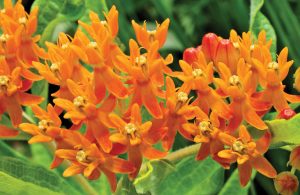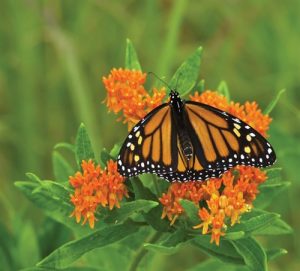Sally Benson May 1, 2017

One of the last times I took my 90-something mother to a garden center, she was immediately attracted to the glowing orange plants at the entry. I hadn’t even put the car in park before her door was open and she was fumbling with the seat belt, eager to hustle over to see what those beautiful plants were.
“Oh,” she sniffed, “it’s milkweed. That’s the plant I used to throw out every time you brought it home from the field next door.”
Well, sort of. True, I used to drag home all manner of plants from the fields surrounding the house (sneezing all the way), but the milkweed pods I collected were likely Asclepias syriaca, common milkweed. And a weed it was.
Name: Asclepias tuberosa
Common name: Butterfly weed
Hardiness: Zones 3 to 9
Mature height: 1 to 2.5 or 3 feet
Mature spread: 1 to 2 feet
Classification: Herbaceous perennial
Landscape use: Among the best choices for butterfly gardens and naturalized or native plant areas; excellent in mixed borders when planted en masse or as brilliantly colored focal points
Ornamental characteristics: Umbels of bright orange to yellow-orange flowers top tall, sturdy stems; if left to seed, a distinctive horny green pod develops, which splits open to reveal seeds borne on silky tails
Asclepias tuberosa is also a “weed” of sorts: Its common name is butterfly weed, and although it’s related to common milkweed, its garden-worthy attributes have elevated it to rock star status in the garden. In fact, A. tuberosa was selected by the Perennial Plant Association as the PPA 2017 Perennial Plant of the Year™ because, well, it’s a great plant. It’s native to the continental U.S. (with the exception of Northeastern states), and it’s found in Ontario and Quebec. It requires very little management or extra care. It’s resistant to all manner of insults, including insect predators and diseases. It’s also resistant to deer. And true to its name, it’s a real butterfly magnet. The flowers provide nectar for a host of butterflies and moths, and the leaves are a favored food source for monarch caterpillars.
Standing up to 2.5 to nearly 3 feet tall, the plants are topped with clusters of blazing orange flowers that serve as beacons for wildlife and garden aficionados alike. Upon closer examination, flowers are easily identified by their “five over five” or “five up and five down” configuration: Each flower has five petals that droop and five erect petals, called hoods, each of which has a horn. These sickleshaped horns curve slightly inward.

This is making it more complicated than a description need be, but it’s an interesting bit of info that heightens one’s appreciation of the intricacy of flowers. If you’re fortunate to have a butterfly’s eye view of the individual flowers, their geometry is fascinating. I’ve stolen across the lawns to study my neighbor’s planting — my garden is most decidedly not orange — and my forays have only increased my interest. From afar, I enjoy a swath of happy color; up close, my neighbor and I have inspected the petals and individual blooms on each umbel. That is, we do so when we can don’t have to compete with the bees and butterflies.
Butterfly weed is easy to grow in average soils in full sun; it’s drought tolerant and handles dry soil well. New growth emerges late in the spring in the Upper Midwest, and flowers bloom reliably from late spring through late summer. They’re often used in cut flower arrangements, and if they’re snipped for vases or simply deadheaded, a new flush of blooms will appear within a month or so.
Once the flowers are spent, 3- to 6-inch-long, spindle-shaped green pods appear and when mature, they’ll split open to reveal soft and silky, silvery white hairs attached to a small seed. (The pods and fuzzy seed tails closely resemble those of the related milkweed.) These wispy hairs help the seed to float on the wind, but the pods are decorative and often are harvested for dried arrangements.
Foliage is a clear, clean, medium green; lance-shaped leaves grow about 2 to 5 inches long, spiraling neatly up each sturdy, fuzzy stem. Despite the relation to milkweed, the stems do not carry the same milky sap that can be irritating to humans and toxic to insects.
When siting Asclepias, be sure to choose a permanent location. Although the plant self-sows if seed pods are left to open and disperse, the mature plant has a very sturdy tap root and does not take well to transplanting. And that’s assuming you’re able to dig up the root intact.
Mom would have loved Asclepias tuberosa if she had been able to get past the “weed” in the name. This native offers long-lasting, reliable and brilliant color, is virtually maintenance free and provides welcome nourishment for pollinators. Give them just a little bit of love and they give back in spades.